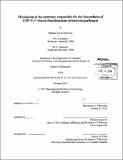Elucidation of the pathways responsible for the biosynthesis of UDP-N,N'-diacetylbacillosamine in bacterial pathogens
Author(s)
Morrison, Michael James
DownloadFull printable version (29.24Mb)
Other Contributors
Massachusetts Institute of Technology. Department of Chemistry.
Advisor
Barbara Imperiali.
Terms of use
Metadata
Show full item recordAbstract
The highly-modified, bacterial sugar N,N'-diacetylbacillosamine (diNAcBac) has been implicated in the pathogenicity of certain microbes through its incorporation onto various protein virulence factors. In particular, diNAcBac is found at the reducing end of glycans in both asparagine (N-linked) and serine/threonine (0-linked) protein glycosylation pathways. The second and third chapters examine the O-linked protein glycosylation pathway responsible for the biosynthesis of the UDP-diNAcBac nucleotide sugar in Neisseria gonorrhoeae and Acinetobacter baumannii. UDP-diNAcBac is biosynthesized from UDP-N-acetylglucosamine through the action of a dehydratase, aminotransferase, and acetyltransferase. Specifically, these enzymes are purified, biochemically characterized, and compared to the N-linked pathway proteins from Campylobacterjejuni. Furthermore, the substrate specificity of the A. baumannii phosphoglycosyltransferase that catalyzes the transfer of UDP-diNAcBac onto undecaprenylphosphate is determined. The fourth chapter explores the structural characterization of the acetyltransferases from the O-linked protein glycosylation pathways in N. gonorrhoeae (PglB-ATD) and A. baumannii (Weel). These enzymes are members of the left-handed [beta]-helix family and are responsible for the acetylation of UDP-2-acetamido-4-amino-2,4,6-trideoxy-[alpha]-D-glucose (UDP-4-amino) to produce UDP-diNAcBac. Based upon these structures, a series of active site mutations are generated and kinetically characterized for both the AcCoA and UDP-4-amino substrates. These results suggest that although each enzyme catalyzes the acetyltransferase reaction with identical substrates, key residues within the binding pockets can lead to a diverse set of catalytic efficiencies. The final three chapters investigate the inhibition of UDP-diNAcBac pathway enzymes in C. jejuni, N. gonorrhoeae, and A. baumannii. The fifth chapter explores a fragment-based approach to identify small molecules that inhibit the aminotransferase in C. jejuni. To this end, a crystal structure of this protein is solved in complex with a fragment molecule and analogs of this compound synthesized. The sixth chapter identifies small molecule acetyltransferase inhibitors through a high-throughput screening effort in collaboration with the Broad Institute. Lastly, the seventh chapter describes a fragment-based approach to establish small molecule inhibitors for the acetyltransferase from N gonorrhoeae.
Description
Thesis: Ph. D., Massachusetts Institute of Technology, Department of Chemistry, February 2014. Cataloged from PDF version of thesis. "February 2014." Includes bibliographical references.
Date issued
2014Department
Massachusetts Institute of Technology. Department of ChemistryPublisher
Massachusetts Institute of Technology
Keywords
Chemistry.